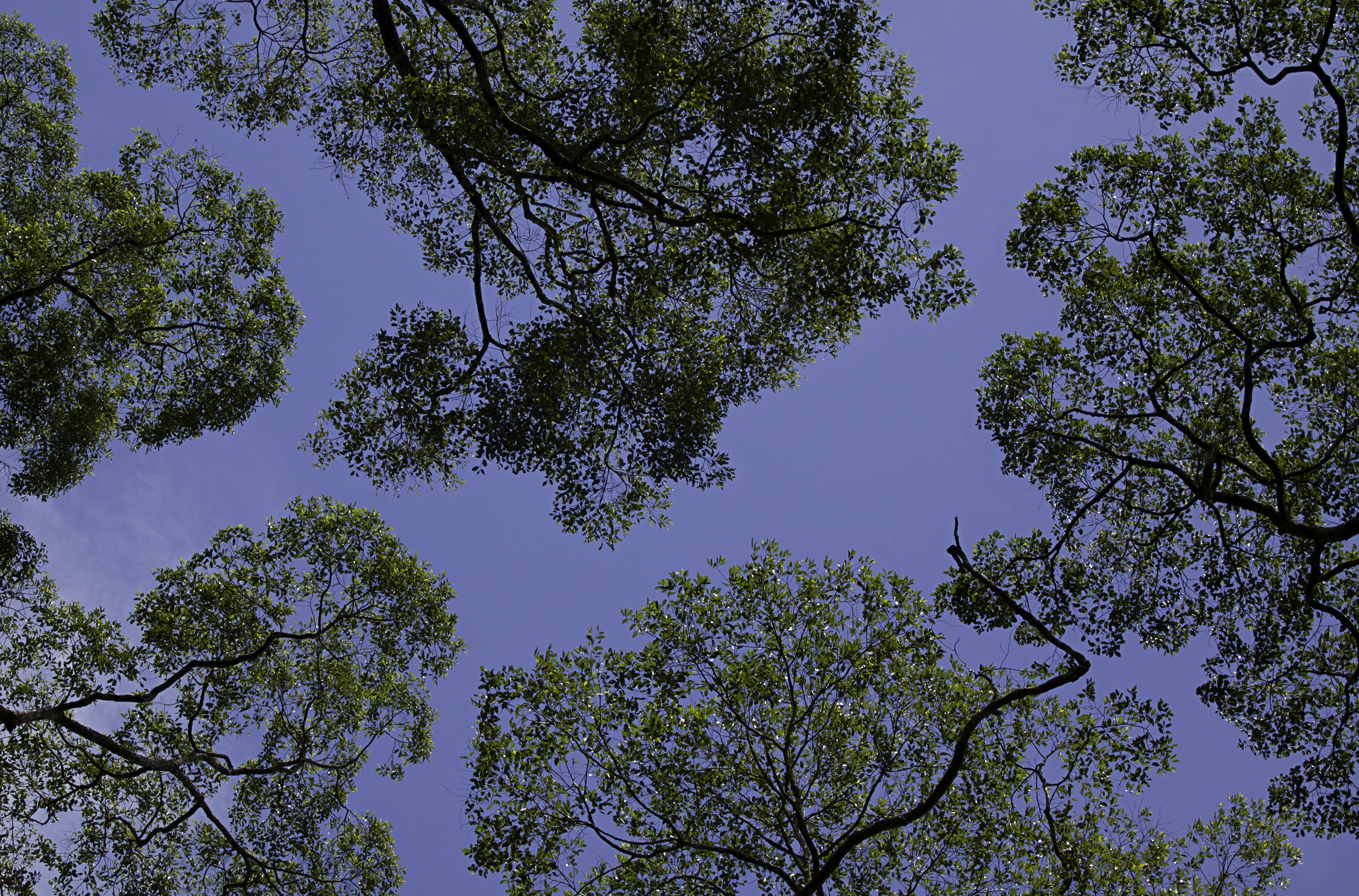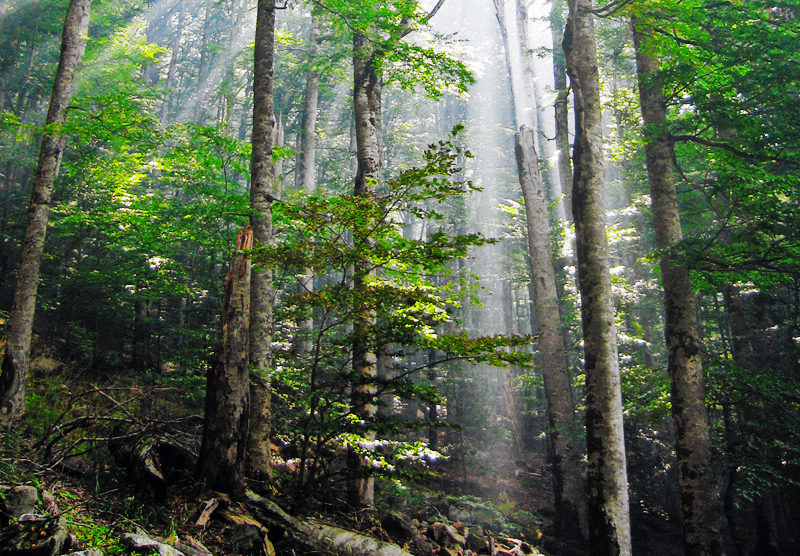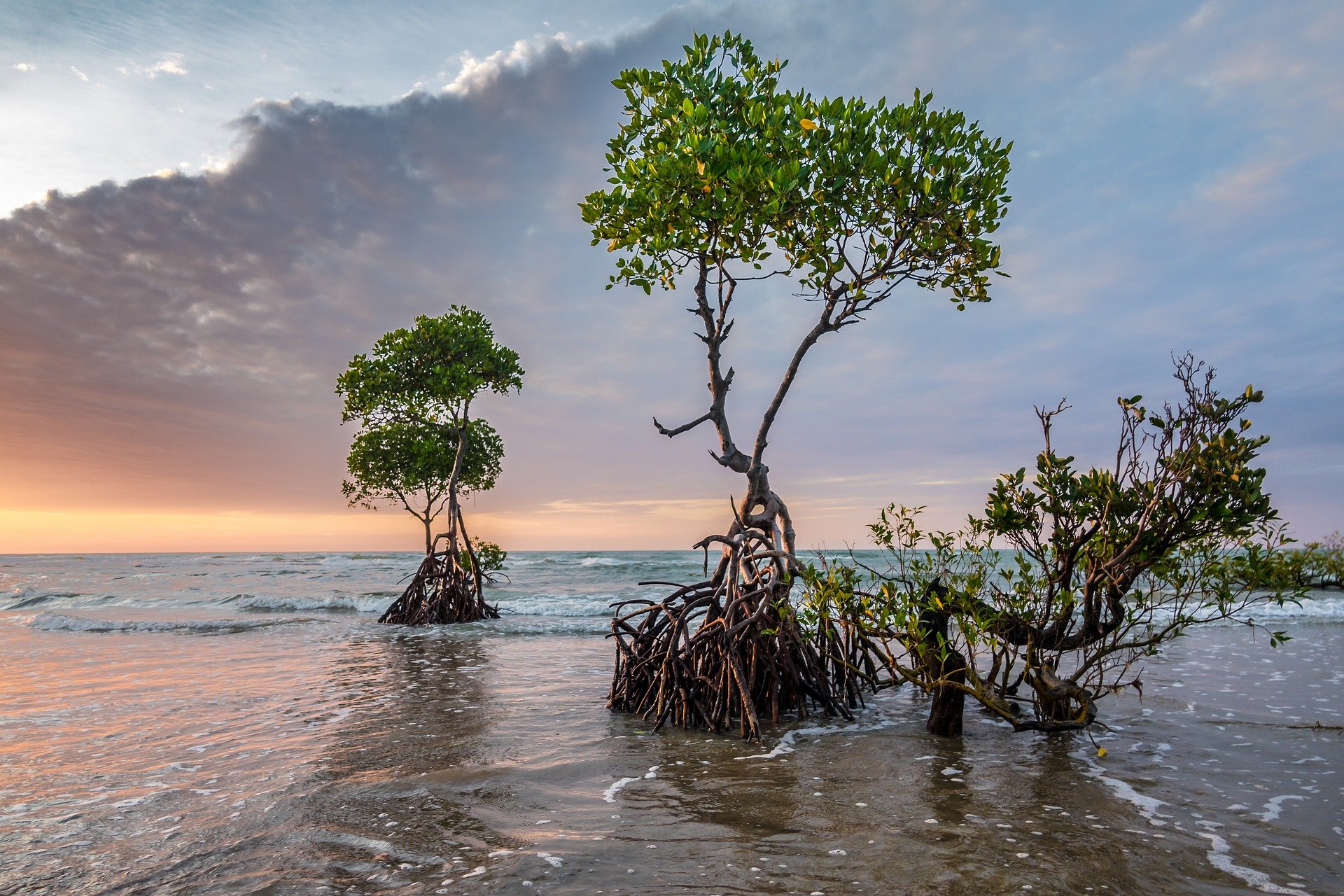|
Greater Green Leafbird
The greater green leafbird (''Chloropsis sonnerati'') is a species of bird in the family Chloropseidae. It is distinguished from the lesser green leafbird (''Chloropsis cyanopogon'') by its powerful beak, yellow throat and eye ring of the female; and lack of a yellow border along the black throat patch found in the male ''C. cyanopogan''. It is found in Brunei, Indonesia, Malaysia, Myanmar, Singapore, and Thailand. In Indonesia, it is found in Sumatra, Borneo, Natuna Islands, Java and Bali. Its natural habitats are subtropical or tropical moist lowland forest and subtropical or tropical mangrove forest, mainly old-growth forest but also secondary forest and edges. It moves quite conspicuously at the canopy level, jumping between branches and flying from tree to tree. It often visits fruiting fig trees, but also takes insects and small invertebrates. The greater green leafbird has a loud voice, consisting of an ascending whistle ''chee-zi-chee''. The species is threatened by ... [...More Info...] [...Related Items...] OR: [Wikipedia] [Google] [Baidu] |
William Jardine (naturalist)
Sir William Jardine, 7th Baronet of Applegarth FRS FRSE FLS FSA (23 February 1800 – 21 November 1874) was a Scottish naturalist. He is known for his editing of a long series of natural history books, ''The Naturalist's Library''. Life and work Jardine was born on 23 February 1800 at 28 North Hanover Street in Edinburgh, the son of Sir Alexander Jardine, 6th baronet of Applegarth and his wife, Jane Maule. He was educated in both York and Edinburgh then studied medicine at Edinburgh University. From 1817 to 1821 he lodged with Rev Dr Andrew Grant at James Square, an arrangement made by his father. Grant was minister of St Andrew's Church on George Street. In his early years, aged only 25, he was elected a fellow of the Royal Society of Edinburgh his proposer being Sir David Brewster. He was a co-founder of the Berwickshire Naturalists' Club, and contributed to the founding of the Ray Society. He was "keenly addicted to field-sports, and a master equally of the rod a ... [...More Info...] [...Related Items...] OR: [Wikipedia] [Google] [Baidu] |
Habitat
In ecology, the term habitat summarises the array of resources, physical and biotic factors that are present in an area, such as to support the survival and reproduction of a particular species. A species habitat can be seen as the physical manifestation of its ecological niche. Thus "habitat" is a species-specific term, fundamentally different from concepts such as environment or vegetation assemblages, for which the term "habitat-type" is more appropriate. The physical factors may include (for example): soil, moisture, range of temperature, and light intensity. Biotic factors will include the availability of food and the presence or absence of predators. Every species has particular habitat requirements, with habitat generalist species able to thrive in a wide array of environmental conditions while habitat specialist species requiring a very limited set of factors to survive. The habitat of a species is not necessarily found in a geographical area, it can be the interior ... [...More Info...] [...Related Items...] OR: [Wikipedia] [Google] [Baidu] |
Birds Of Malesia
Birds are a group of warm-blooded vertebrates constituting the class Aves (), characterised by feathers, toothless beaked jaws, the laying of hard-shelled eggs, a high metabolic rate, a four-chambered heart, and a strong yet lightweight skeleton. Birds live worldwide and range in size from the bee hummingbird to the ostrich. There are about ten thousand living species, more than half of which are passerine, or "perching" birds. Birds have whose development varies according to species; the only known groups without wings are the extinct moa and elephant birds. Wings, which are modified forelimbs, gave birds the ability to fly, although further evolution has led to the loss of flight in some birds, including ratites, penguins, and diverse endemic island species. The digestive and respiratory systems of birds are also uniquely adapted for flight. Some bird species of aquatic environments, particularly seabirds and some waterbirds, have further evolved for swimming. ... [...More Info...] [...Related Items...] OR: [Wikipedia] [Google] [Baidu] |
Chloropsis
The leafbirds (Chloropseidae) are a family of small passerine bird species found in the Indian Subcontinent and Southeast Asia. They were formerly grouped with the ioras and fairy-bluebirds in the family Irenidae. As presently defined, the leafbird family is monogeneric, with all species placed in the genus ''Chloropsis''. Description The leafbirds range in size from , and in weight from . They resemble bulbuls, but whereas that group tends to be drab in colour, leafbirds are brightly plumaged, with the predominant green over the body giving rise to their common name. The family is mostly sexually dimorphic in their plumage, this can vary from the highly dimorphic orange-bellied leafbird to the Philippine leafbird, which exhibits no sexual dimorphism. Most of the differences between the sexes are in the extent of the other colours in the plumage, particularly in the colours around the head and the blue or black face mask, with females having less colour and a less extensive ... [...More Info...] [...Related Items...] OR: [Wikipedia] [Google] [Baidu] |
Naturalis Biodiversity Center - RMNH
Naturalis Biodiversity Center ( nl, Nederlands Centrum voor Biodiversiteit Naturalis) is a national museum of natural history and a research center on biodiversity in Leiden, Netherlands. It was named the European Museum of the Year 2021. Although its current name and organization are relatively recent, the history of Naturalis can be traced back to the early 1800s. Its collection includes approximately 42 million specimens, making it one of the largest natural history collections in the world. History The beginnings of Naturalis go back to the creation of the Rijksmuseum van Natuurlijke Historie (abbreviated RMNH, National Museum of Natural History) by Dutch King William I on August 9, 1820. In 1878, the geological and mineralogical collections of the museum were split off into a separate museum, remaining distinct until the merger of the Rijksmuseum van Natuurlijke Historie with the Rijksmuseum van Geologie en Mineralogie (abbreviated RGM) in 1984, to form the Nationaal N ... [...More Info...] [...Related Items...] OR: [Wikipedia] [Google] [Baidu] |
Cage-bird Trade
Wildlife trade refers to the of products that are derived from non-domesticated animals or plants usually extracted from their natural environment or raised under controlled conditions. It can involve the trade of living or dead individuals, tissues such as skins, bones or meat, or other products. Legal wildlife trade is regulated by the United Nations' Convention on International Trade in Endangered Species of Wild Fauna and Flora (CITES), which currently has 184 member countries called ''Parties''. Illegal wildlife trade is widespread and constitutes one of the major illegal economic activities, comparable to the traffic of drugs and weapons. Wildlife trade is a serious conservation problem, has a negative effect on the viability of many wildlife populations and is one of the major threats to the survival of vertebrate species.The illegal wildlife trade has been linked to the emergence and spread of new infectious diseases in humans, including emergent viruses. Global initia ... [...More Info...] [...Related Items...] OR: [Wikipedia] [Google] [Baidu] |
Ficus
''Ficus'' ( or ) is a genus of about 850 species of woody trees, shrubs, vines, epiphytes and hemiepiphytes in the family Moraceae. Collectively known as fig trees or figs, they are native throughout the tropics with a few species extending into the semi-warm temperate zone. The common fig (''F. carica'') is a temperate species native to southwest Asia and the Mediterranean region (from Afghanistan to Portugal), which has been widely cultivated from ancient times for its fruit, also referred to as figs. The fruit of most other species are also edible though they are usually of only local economic importance or eaten as bushfood. However, they are extremely important food resources for wildlife. Figs are also of considerable cultural importance throughout the tropics, both as objects of worship and for their many practical uses. Description ''Ficus'' is a pantropical genus of trees, shrubs, and vines occupying a wide variety of ecological niches; most are evergreen, but ... [...More Info...] [...Related Items...] OR: [Wikipedia] [Google] [Baidu] |
Canopy (biology)
In biology, the canopy is the aboveground portion of a plant community, plant cropping or crop, formed by the collection of individual Crown (botany), plant crowns. In forest ecology, canopy also refers to the upper layer or habitat zone, formed by mature tree crowns and including other biological organisms (epiphytes, lianas, Arboreal, arboreal animals, etc.). The communities that inhabit the canopy layer are thought to be involved in maintaining forest diversity, resilience, and functioning. Sometimes the term canopy is used to refer to the extent of the outer layer of leaves of an individual tree or group of trees. Shade trees normally have a dense canopy that blocks light from lower growing plants. Observation Early observations of canopies were made from the ground using binoculars or by examining fallen material. Researchers would sometimes erroneously rely on extrapolation by using more reachable samples taken from the understory. In some cases, they would use unc ... [...More Info...] [...Related Items...] OR: [Wikipedia] [Google] [Baidu] |
Secondary Forest
A secondary forest (or second-growth forest) is a forest or woodland area which has re-grown after a timber harvest or clearing for agriculture, until a long enough period has passed so that the effects of the disturbance are no longer evident. It is distinguished from an old-growth forest (primary or primeval forest), which has not recently undergone such disruption, and complex early seral forest, as well as third-growth forests that result from harvest in second growth forests. Secondary forest regrowing after timber harvest differs from forest regrowing after natural disturbances such as fire, insect infestation, or windthrow because the dead trees remain to provide nutrients, structure, and water retention after natural disturbances. However, often after natural disturbance the timber is harvested and removed from the system, in which case the system more closely resembles secondary forest rather than seral forest. Description Depending on the forest, the development ... [...More Info...] [...Related Items...] OR: [Wikipedia] [Google] [Baidu] |
Old-growth Forest
An old-growth forestalso termed primary forest, virgin forest, late seral forest, primeval forest, or first-growth forestis a forest that has attained great age without significant disturbance, and thereby exhibits unique ecological features, and might be classified as a climax community. The Food and Agriculture Organization of the United Nations defines primary forests as naturally regenerated forests of native tree species where there are no clearly visible indications of human activity and the ecological processes are not significantly disturbed. More than one-third (34 percent) of the world's forests are primary forests. Old-growth features include diverse tree-related structures that provide diverse wildlife habitat that increases the biodiversity of the forested ecosystem. Virgin or first-growth forests are old-growth forests that have never been logged. The concept of diverse tree structure includes multi-layered canopies and canopy gaps, greatly varying tree heig ... [...More Info...] [...Related Items...] OR: [Wikipedia] [Google] [Baidu] |
Mangrove Forest
Mangrove forests, also called mangrove swamps, mangrove thickets or mangals, are productive wetlands that occur in coastal intertidal zones. Mangrove forests grow mainly at tropical and subtropical latitudes because mangroves cannot withstand freezing temperatures. There are about 80 different species of mangroves, all of which grow in areas with low-oxygen soil, where slow-moving waters allow fine sediments to accumulate.What is a mangrove forest? National Ocean Service, NOAA. Updated: 25 March 2021. Retrieved: 4 October 2021. Many mangrove forests can be recognised by their dense tangle of prop roots that make the trees appear to be standing on stilts above the water. This tangle of roots allows the trees to handle the daily rise and fall of tides, which means that most mangroves get flooded at least twice per da ... [...More Info...] [...Related Items...] OR: [Wikipedia] [Google] [Baidu] |
Subtropical Or Tropical Moist Lowland Forest
Tropical and subtropical moist broadleaf forests (TSMF), also known as tropical moist forest, is a subtropical and tropical forest habitat type defined by the World Wide Fund for Nature. Description TSMF is generally found in large, discontinuous patches centered on the equatorial belt and between the Tropic of Cancer and Tropic of Capricorn, TSMF are characterized by low variability in annual temperature and high levels of rainfall of more than annually. Forest composition is dominated by evergreen and semi-deciduous tree species. These trees number in the thousands and contribute to the highest levels of species diversity in any terrestrial major habitat type. In general, biodiversity is highest in the forest canopy. The canopy can be divided into five layers: overstory canopy with emergent crowns, a medium layer of canopy, lower canopy, shrub level, and finally understory. These forests are home to more species than any other terrestrial ecosystem: Half of the world's ... [...More Info...] [...Related Items...] OR: [Wikipedia] [Google] [Baidu] |

.jpg)






